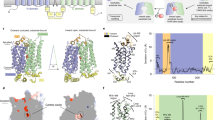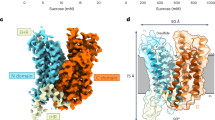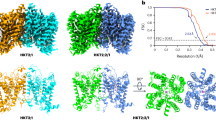Abstract
SWEETs and their prokaryotic homologues are monosaccharide and disaccharide transporters that are present from Archaea to plants and humans1,2,3. SWEETs play crucial roles in cellular sugar efflux processes: that is, in phloem loading4, pollen nutrition5 and nectar secretion6. Their bacterial homologues, which are called SemiSWEETs, are among the smallest known transporters1,3. Here we show that SemiSWEET molecules, which consist of a triple-helix bundle, form symmetrical, parallel dimers, thereby generating the translocation pathway. Two SemiSWEET isoforms were crystallized, one in an apparently open state and one in an occluded state, indicating that SemiSWEETs and SWEETs are transporters that undergo rocking-type movements during the transport cycle. The topology of the triple-helix bundle is similar yet distinct to that of the basic building block of animal and plant major facilitator superfamily (MFS) transporters (for example, GLUTs and SUTs). This finding indicates two possibilities: that SWEETs and MFS transporters evolved from an ancestral triple-helix bundle or that the triple-helix bundle represents convergent evolution. In SemiSWEETs and SWEETs, two triple-helix bundles are arranged in a parallel configuration to produce the 6- and 6 + 1-transmembrane-helix pores, respectively. In the 12-transmembrane-helix MFS transporters, four triple-helix bundles are arranged into an alternating antiparallel configuration, resulting in a much larger 2 × 2 triple-helix bundle forming the pore. Given the similarity of SemiSWEETs and SWEETs to PQ-loop amino acid transporters and to mitochondrial pyruvate carriers (MPCs), the structures characterized here may also be relevant to other transporters in the MtN3 clan7,8,9. The insight gained from the structures of these transporters and from the analysis of mutations of conserved residues will improve the understanding of the transport mechanism, as well as allow comparative studies of the different superfamilies involved in sugar transport and the evolution of transporters in general.
This is a preview of subscription content, access via your institution
Access options
Subscribe to this journal
Receive 51 print issues and online access
$199.00 per year
only $3.90 per issue
Buy this article
- Purchase on Springer Link
- Instant access to full article PDF
Prices may be subject to local taxes which are calculated during checkout




Similar content being viewed by others
References
Sosso, D., Chen, L. Q. & Frommer, W. B. in Encyclopedia of Biophysics Vol. 5 (ed. Roberts, G. ) 2556–2558 (Springer, 2013)
Chen, L. Q. et al. Sugar transporters for intercellular exchange and nutrition of pathogens. Nature 468, 527–532 (2010)
Xuan, Y. H. et al. Functional role of oligomerization for bacterial and plant SWEET sugar transporter family. Proc. Natl Acad. Sci. USA 110, E3685–E3694 (2013)
Chen, L. Q. et al. Sucrose efflux mediated by SWEET proteins as a key step for phloem transport. Science 335, 207–211 (2012)
Sun, M. X., Huang, X. Y., Yang, J., Guan, Y. F. & Yang, Z. N. Arabidopsis RPG1 is important for primexine deposition and functions redundantly with RPG2 for plant fertility at the late reproductive stage. Plant Reprod. 26, 83–91 (2013)
Lin, I. W. et al. Nectar secretion requires sucrose phosphate synthases and the sugar transporter SWEET9. Nature 508, 546–549 (2014)
Jezegou, A. et al. Heptahelical protein PQLC2 is a lysosomal cationic amino acid exporter underlying the action of cysteamine in cystinosis therapy. Proc. Natl Acad. Sci. USA 109, E3434–E3443 (2012)
Herzig, S. et al. Identification and functional expression of the mitochondrial pyruvate carrier. Science 337, 93–96 (2012)
Bricker, D. K. et al. A mitochondrial pyruvate carrier required for pyruvate uptake in yeast, Drosophila, and humans. Science 337, 96–100 (2012)
Wright, E. M. Glucose transport families SLC5 and SLC50. Mol. Aspects Med. 34, 183–196 (2013)
Cura, A. J. & Carruthers, A. Role of monosaccharide transport proteins in carbohydrate assimilation, distribution, metabolism, and homeostasis. Compr. Physiol. 2, 863–914 (2012)
Lalonde, S., Wipf, D. & Frommer, W. B. Transport mechanisms for organic forms of carbon and nitrogen between source and sink. Annu. Rev. Plant Biol. 55, 341–372 (2004)
Kumar, H. et al. Structure of sugar-bound LacY. Proc. Natl Acad. Sci. USA 111, 1784–1788 (2014)
Deng, D. et al. Crystal structure of the human glucose transporter GLUT1. Nature 510, 121–125 (2014)
Abramson, J. & Wright, E. M. Structure and function of Na+-symporters with inverted repeats. Curr. Opin. Struct. Biol. 19, 425–432 (2009)
Antony, G. et al. Rice xa13 recessive resistance to bacterial blight is defeated by induction of the disease susceptibility gene Os-11N3 . Plant Cell 22, 3864–3876 (2010)
Hamada, M., Wada, S., Kobayashi, K. & Satoh, N. Ci-Rga, a gene encoding an MtN3/saliva family transmembrane protein, is essential for tissue differentiation during embryogenesis of the ascidian Ciona intestinalis . Differentiation 73, 364–376 (2005)
Yan, N. Structural advances for the major facilitator superfamily (MFS) transporters. Trends Biochem. Sci. 38, 151–159 (2013)
von Heijne, G. & Gavel, Y. Topogenic signals in integral membrane proteins. Eur. J. Biochem. 174, 671–678 (1988)
Niittylä, T., Fuglsang, A. T., Palmgren, M. G., Frommer, W. B. & Schulze, W. X. Temporal analysis of sucrose-induced phosphorylation changes in plasma membrane proteins of Arabidopsis . Mol. Cell. Proteomics 6, 1711–1726 (2007)
Ponting, C. P., Mott, R., Bork, P. & Copley, R. R. Novel protein domains and repeats in Drosophila melanogaster: insights into structure, function, and evolution. Genome Res. 11, 1996–2008 (2001)
Zhai, Y., Heijne, W. H., Smith, D. W. & Saier, M. H., Jr Homologues of archaeal rhodopsins in plants, animals and fungi: structural and functional predications for a putative fungal chaperone protein. Biochim. Biophys. Acta 1511, 206–223 (2001)
Henderson, P. J., Giddens, R. A. & Jones-Mortimer, M. C. Transport of galactose, glucose and their molecular analogues by Escherichia coli K12. Biochem. J. 162, 309–320 (1977)
Forrest, L. R., Kramer, R. & Ziegler, C. The structural basis of secondary active transport mechanisms. Biochim. Biophys. Acta 1807, 167–188 (2011)
Kaback, H. R., Smirnova, I., Kasho, V., Nie, Y. & Zhou, Y. The alternating access transport mechanism in LacY. J. Membr. Biol. 239, 85–93 (2011)
Forrest, L. R. & Rudnick, G. The rocking bundle: a mechanism for ion-coupled solute flux by symmetrical transporters. Physiology 24, 377–386 (2009)
Khare, D., Oldham, M. L., Orelle, C., Davidson, A. L. & Chen, J. Alternating access in maltose transporter mediated by rigid-body rotations. Mol. Cell 33, 528–536 (2009)
De Zutter, J. K., Levine, K. B., Deng, D. & Carruthers, A. Sequence determinants of GLUT1 oligomerization: analysis by homology-scanning mutagenesis. J. Biol. Chem. 288, 20734–20744 (2013)
Loqué, D., Lalonde, S., Looger, L. L., von Wirén, N. & Frommer, W. B. A cytosolic trans-activation domain essential for ammonium uptake. Nature 446, 195–198 (2007)
Sun, J. et al. Crystal structure of the plant dual-affinity nitrate transporter NRT1.1. Nature 507, 73–77 (2014)
Kabsch, W. XDS. Acta Crystallogr. D 66, 125–132 (2010)
Diederichs, K. & Karplus, P. A. Improved R-factors for diffraction data analysis in macromolecular crystallography. Nature Struct. Biol. 4, 269–275 (1997)
Otwinowski, Z. & Minor, W. Processing of X-ray diffraction data collected in oscillation mode. Methods Enzymol. 276, 307–326 (1997)
Schneider, T. R. & Sheldrick, G. M. Substructure solution with SHELXD. Acta Crystallogr. D 58, 1772–1779 (2002)
Adams, P. D. et al. PHENIX: a comprehensive Python-based system for macromolecular structure solution. Acta Crystallogr. D 66, 213–221 (2010)
McCoy, A. J. Solving structures of protein complexes by molecular replacement with Phaser. Acta Crystallogr. D 63, 32–41 (2007)
Cowtan, K. ‘dm': An automated procedure for phase improvement by density modification. Joint CCP4 and ESF-EACBM Newsletter on Protein Crystallography 31, 34–38 (1994)
Emsley, P. & Cowtan, K. Coot: model-building tools for molecular graphics. Acta Crystallogr. D 60, 2126–2132 (2004)
Chen, V. B. et al. MolProbity: all-atom structure validation for macromolecular crystallography. Acta Crystallogr. D 66, 12–21 (2010)
DeLano, W. L. The PyMOL molecular graphics system. http://www.pymol.org (DeLano Scientific, Palo Alto, California, 2008)
Sun, L. et al. Crystal structure of a bacterial homologue of glucose transporters GLUT1–4. Nature 490, 361–366 (2012)
Wieczorke, R. et al. Concurrent knock-out of at least 20 transporter genes is required to block uptake of hexoses in Saccharomyces cerevisiae . FEBS Lett. 464, 123–128 (1999)
Gietz, R. D. & Schiestl, R. H. Large-scale high-efficiency yeast transformation using the LiAc/SS carrier DNA/PEG method. Nature Protocols 2, 38–41 (2007)
Acknowledgements
We thank the staff at beamlines 23ID-B and 23ID-D (APS, Argonne National Laboratory) and S. Russi and the staff at beamlines 11-1 and 12-2 (SSRL, SLAC National Laboratory) for assistance at the synchrotrons. We thank the Kobilka laboratory for help and advice on the LCP. This work was made possible by support from Stanford University and the Harold and Leila Y. Mathers Charitable Foundation to L.F. and from the Division of Chemical Sciences, Geosciences and Biosciences, Office of Basic Energy Sciences at the US Department of Energy (DOE) under grant number DE-FG02-04ER15542 to W.B.F. Part of this work is based upon research conducted at the APS on the Northeastern Collaborative Access Team beamlines, which are supported by a grant from the National Institute of General Medical Sciences (P41 GM103403) from the National Institutes of Health. Use of the APS, an Office of Science User Facility operated for the DOE Office of Science by Argonne National Laboratory, was supported by the DOE under contract number DE-AC02-06CH11357.
Author information
Authors and Affiliations
Contributions
Y.X., W.B.F. and L.F. conceived and designed experiments. Y.X. and Y.T. performed expression, purification, crystallization, data collection and crystallography. C.F. performed functional experiments. S.X. performed biochemical characterization. L.S.C. and L.-Q.C. performed alignments and functional experiments. K.P. performed data collection and assisted crystallography. L.F. contributed to crystallization, data collection and crystallography. Y.X., Y.T., L.S.C., C.F., L.-Q.C., W.B.F. and L.F. analysed the data. L.F. and W.B.F. wrote the manuscript.
Corresponding author
Ethics declarations
Competing interests
The authors declare no competing financial interests.
Extended data figures and tables
Extended Data Figure 1 Sequence alignment.
The secondary structure is shown above the alignment. Protein sequences were aligned using ClustalW and manually adjusted. The N-terminal part (first THB) and C-terminal part (second THB) of A. thaliana SWEET1 were separately used for alignment and are labelled A. thaliana SWEET1-N and A. thaliana SWEET1-C, respectively.
Extended Data Figure 2 Vibrio sp. SemiSWEET dimer in the crystal.
Crystal packing in the lipid bilayer environment shows the formation of the dimer. One protomer is shown in green, and the other is shown in purple.
Extended Data Figure 3 Subunit stoichiometry of SemiSWEET.
a, Purified Vibrio sp. SemiSWEET (predicted molecular weight, 11.1 kDa) remains as a dimer after SDS–PAGE. b, Crosslinking of purified B. japonicum SemiSWEET (theoretical molecular weight, 10.1 kDa) in detergent solution. Increasing amounts of disuccinimidyl suberate (DSS; 0.02 mM, 0.2 mM and 2 mM) were used to crosslink B. japonicum SemiSWEET. The protein was analysed by SDS–PAGE and stained with Coomassie blue.
Extended Data Figure 4 Crystal packing of L. biflexa SemiSWEET.
The crystal lattice structure of L. biflexa SemiSWEET shows dimer formation in the membrane. One protomer is shown in red, and the other is shown in blue.
Extended Data Figure 5 Conserved tryptophan and asparagine residues in A. thaliana SWEET1 are required for transport activity.
a, Functional analysis of A. thaliana SWEET1–GFP (green fluorescent protein) fusion transport activity in the EBY4000 yeast strain. The point mutations W56A, N73A, W176A and N192A failed to complement the growth defect of EBY4000 in synthetic medium supplemented with 2% glucose as the only carbon source. Growth was unaffected in control medium containing 2% maltose. An empty vector and A. thaliana SWEET1–GFP were used as the negative and positive controls, respectively. b–g, Membrane localization of the wild-type and mutant A. thaliana SWEET1 was confirmed by imaging of GFP. The empty vector negative control (b) shows the cytoplasmic localization of GFP, while the wild-type and W56A, N73A, W176A and N192A mutants (c–g) show membrane localization, suggesting that the phenotype of the mutated transporters is not due to mislocalization.
Extended Data Figure 6 Transmembrane-helix arrangements in SWEET, MFS and G-protein-coupled receptor (GPCR) proteins.
Ribbon representations of a three-transmembrane-helix unit in a SWEET (left), a GPCR (centre) and an MFS (right) are shown (top), with their respective topologies (bottom). The same colour scheme is used for all three proteins.
Extended Data Figure 7 Proposed transport model and pathway for building SWEET and MFS transporters.
a, Alternating access model for SemiSWEET transport. One protomer is shown in purple, and the other is shown in green. The putative substrate is shown as an orange hexagon. b, Proposed pathway for constructing SemiSWEET, SWEET or MFS transporters from the primitive THB. The same colour scheme is used for all THBs. The position of TM3 relative to TM1 and TM2 of the THB in SWEET or MFS is illustrated by coloured circles, viewed from the N terminus. Note that the THB in SWEET and the THB in MFS are roughly mirror images of each other.
Supplementary information
Supplementary Information
This file contains a Supplementary Discussion and additional references. (PDF 79 kb)
Rights and permissions
About this article
Cite this article
Xu, Y., Tao, Y., Cheung, L. et al. Structures of bacterial homologues of SWEET transporters in two distinct conformations. Nature 515, 448–452 (2014). https://doi.org/10.1038/nature13670
Received:
Accepted:
Published:
Issue Date:
DOI: https://doi.org/10.1038/nature13670
This article is cited by
-
Oligomeric organization of membrane proteins from native membranes at nanoscale spatial and single-molecule resolution
Nature Nanotechnology (2024)
-
The K/HDEL receptor does not recycle but instead acts as a Golgi-gatekeeper
Nature Communications (2023)
-
Solid-state NMR 13C and 15 N resonance assignments of Vibrio sp. SemiSWEET transporter in lipid bilayers
Biomolecular NMR Assignments (2022)
-
Physiological and transcriptome analysis of Magnolia denudata leaf buds during long-term cold acclimation
BMC Plant Biology (2021)
-
The ins and outs of SWEETs in plants: Current understanding of the basics and their prospects in crop improvement
Journal of Biosciences (2021)
Comments
By submitting a comment you agree to abide by our Terms and Community Guidelines. If you find something abusive or that does not comply with our terms or guidelines please flag it as inappropriate.



